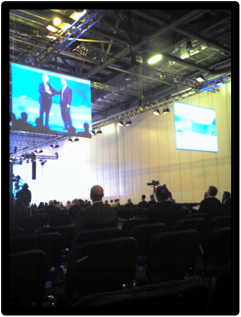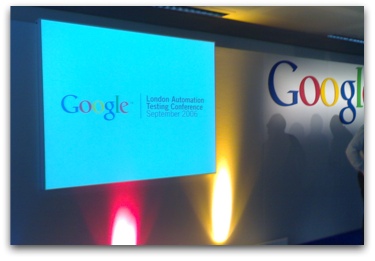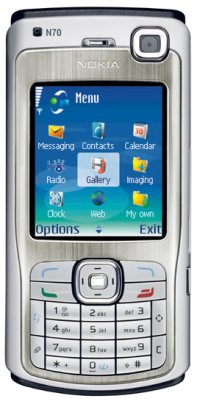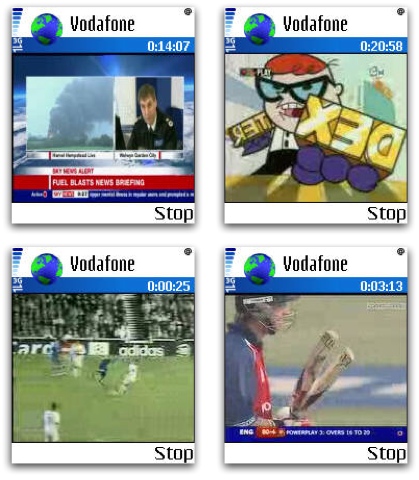Annotations
Of all the new language features in Java SE 5, annotations were probably the one thing I was nervous about. The benefits are clear for things like the Java Persistence API, and there’s no going back once you’ve used them. For some of the other annotations, I didn’t really see the point. I do now.
I was chatting with Paul the other day about a feature of the language neither of us fully grokked. Here’s the trimmed down example, and it’s perfectly legal Java that compiles and runs just fine…
Symbian Smartphone Show

This year I wanted to catch up with…
- Opera, and their platform. Looks like with Opera 9, sometime in 2007, we’ll have off-line widgets which can embed themselves in the OS as native-looking applications.
- Google, to see how they built and tested their wonderful wonderful mobile maps application. I guess it was asking too much to see if they had solved the problems of testing mobile applications since last month :-) but it was a great opportunity to have a chat with them about the application.
- Sybase, to get a grip on their Anywhere range of products. I’ve had a long-standing “to do” item to look into what Sybase are offering. The two main product areas I’m interested in are M-Business Anywhere and SQL Anywhere. Unfortunately, they weren’t pushing them at the show, so I was only able to get a rough overview. Still that’s more than I knew before I went.
There were two or three seminars I wouldn’t have minded attending, but they were spread so far apart (in time) that I just couldn’t justify hanging around for so long for the odd 30 minute talk. However, there are some supporting podcasts available.
Google LTAC

Google hosted a Test Automation Conference at their London offices on the 7th and 8th of September. The videos of the presentations are on Google Video, so rather than do a blow-by-blow account of each talk, I thought I’d note down what I saw as the main themes.
- Domain languages — and literate programming. I saw a number of
threads where quite rich languages were used to express unit tests,
either built-in to systems (like Fit) or via a library for Java. The
literate side means writing tests along the lines of
assertThat(thePage, has(selectBox().named("region"))), with the trick being of removing the dots and brackets to produce a test that a customer or a business analyst could understand. I have my doubts about the effort/reward of that, but I can see an advantage if you can attach that style of writing to a story or requirement. - Performance measurement — looks like there’s a lot to be gained from running nightly benchmarks against code commits, so developers can see when they’ve checked in something that hurts performance. That would be a heck of a lot more effective than my approach of reaching for the code profiler every now and then. But how do you know your benchmarks reflect the performance of deployed systems running on production hardware? You don’t, but if you’re the sort of organization that uses many cheap machines in preferences to a few large servers, you’re in a better position.
- Configuration and deployment — there’s some interesting work going on dealing with exploring large spaces of configuration options, and in testing against deployed systems. To take the latter first, some organizations strongly separate production machines from development machines, which makes testing web services (as an example) difficult because of firewall issues. That needs to change. Regarding configuration, there’s some smart work going on to automatically explore the space of configuration options using some random and some AI techniques. The study presented suggests that sampling the space of options is a pretty good approximation to exhaustive search, at least more so than you’d maybe guess.
- Mobile — the conference kicked off with Shannon Maher pointing out the difficulties of testing mobile applications (11,000 user agents x connectivity options x carriers … = combinatorial pain). The take-away point from that presentation was that this is an important problem to solve, with prizes for anyone who can solve it. Given that this was Google’s London director of mobile and director of engineering talking, I think it’s safe to assume that the prizes aren’t just toasters. But that was pretty much all that was said about mobile from an application developer perspective, which was surprising. Expect much more to be said in the future.
A few comments or thoughts that caught my attention: “any standard [W3C, OASIS, etc] without a test set doesn’t exist”; a round of applause for something described as being not XML; don’t write huge chunks of Javascript, instead separate your concerns as you would with other languages; “the interesting thing about objects is the messages between them, not their state”.
Open Source Java ME
The Rich Green video confirmed that Java ME (CLDC and CDC) are being open sourced. I believe the opening of the Standard Edition was well anticipated, but the inclusion of the Micro Edition is great news. The timing is also impressive: roll out by the end of 2006.
Presumably this will ensure Java is included by more handsets and other devices, including as a default on more Linux-based devices. What happens there is probably determined by the license choice. The intriguing possibly is that ME technology could become common place on device other than phones. Although some will shudder at that idea, remembering back to the original diagrams describing “profiles” and “configurations”, it’s what the technology was designed for: a configuration, like CLDC, is a set of classes for a range of devices; a profile, such as MIDP, is the collection of APIs for a vertical market.
Vendor JAM
Try to catch Just a Minute on the radio/internet sometime. It’s a long-running panel game. A player of the game will try to talk on a subject for 60 seconds without the other participants spotting hesitation, deviation or repetition.
I think this could be the magic formula for making vendor presentations at conferences more interesting. A chairman introduces a subject (SOA, web services, RoI, …) and one of the contestants starts taking until… bzzz… an opponent spots one of the three violations. If the challenge is correct, they get points and take on the topic for the remaining time. The winner gets to give out t-shirts, CDs or give closing remarks or something.
NetBeans, Mobility, Mac
The NetBeans mobility pack includes a cute drag-and-drop Java ME application builder. Since day one I’ve been asking: does it run on a Mac yet? Does it run on a Mac yet? Does it run on a Mac yet?…and the answer has been “no”. Running it across the network via X11 or similar, or running inside a Windows emulator, isn’t ideal so I’ve more-or-less avoided NetBeans.
However, blogs from Lukas Hasik and Florian Beer pointed out that you can hack the mobility downloads to make it run on Mac OS X, so I took the plunge with it under NetBeans 5.5 beta with the enterprise pack. And sure, it works:
Nokia N70

It’d been a long time since I’d used a Nokia handset, so I decided to spend a while—pretty much the last 12 months in fact—with a Series 60 Nokia N70. I now need to get this off my chest: I hate this handset, and I just don’t like Series 60.
I’m starting to wonder if Sony Ericsson have re-wired my brain away from the Nokia UI.
I quite liked Series 40, and it’s still highly usable despite often looking dated. And I’ve really tried to get into Series 60, but none of the Smartphone Hacks have helped, and none of the applications (including Lifeblog) and none of the 3G features (like mobile TV) make it worth the pain.
Jini, JavaSpaces, JXTA
…the holy trinity of cool technologies. Yet also the perennial underachievers.
I worked with Jono on a Jini/JavaSpaces application for a publisher a while back, and I think it was pretty successful. Certainly it worked well enough, and when the corporate compliance and review police dropped in to do a standard check-up they liked what they saw. Since then, though, it seems to be “risky” to look at these technologies, and instead messaging queuing (and now web services) are a safer bet.
JavaUK06
Last month Sun put on a sumptuous mini developer conference in London, called JavaUK06. I went along with the usual crowd and although it wasn’t exactly a cut-down JavaOne, it was a worthwhile day.
Let’s get the bad stuff out of the way first. The initial keynote was out of place for a Java-based show. One wag explained it to me: sitting through it was the cost of admission. Fair enough. Then Craig McClanahan put on a high-density cover-all-bases web framework presentation. He lost the crowd when switching to an IDE to show us code that was too tiny to read and then refused to adjust the font.
Tags
If you’re interested in the growth and use of tagging, or folksonomy generally, take some time to read The Structure of Collaborative Tagging Systems (PDF). The paper discusses what people tag (using data from Del.icio.us), the purpose of tagging (“fundamentally about sensemaking”), some of the problems of tagging (in particular polysemy and synonymy), and compares tagging to taxonomy.
One aspect I found interesting was the dynamics of tagging. In Del.icio.us, individuals users tag URLs how ever they like. When you look at all the tags of any given URL you “might expect that individuals’ varying tag collections and personal preferences, compounded by an ever-increasing number of users, would yield a chaotic pattern of tags”. The paper reports otherwise. A stable pattern quickly emerges, which implies a consensus is formed after as little as 100 tags. The authors suggest imitation and shared knowledge between users is the cause of this. There may be a link here with The Wisdom of Crowds, which is still in my bought-but-not-read pile.
JasperReports, JFreeChart, JExcelAPI
I had some reporting to add to an application last year, and rather than code something from scratch, I decided to dig around for a package to give us something we could grow with—something to give us a framework, that we could use to make more sophisticated reports when the time came for them.
JasperReports looks good: you specify the data going into the report, you declaratively set up the report in XML, and at the last minute you decide the format you want for output: HTML, Excel, PDF. There’s even built-in support for it in WebWork. “Over 1 million” downloads can’t be wrong.
Mobile TV

I’ve spent a few weeks watching the Vodafone 3G mobile TV service. It’s a TV-over-IP system, with a fair range of channels, such as MTV, Sky News, CNN, Cartoon Network, Discovery, plus various sports. Here’s what I’ve noticed so far:
- It’s not on-demand, so you watch what’s broadcast.
- There’s no EPG, which is strange. Not even an “now and next”.
- News channels like to put text overlays on the picture, but you can’t read anything but the main headline ticker. This is a digital medium, so you’d expect one day for the text to be transmitted in a way that let’s the device render it appropriately.
- Yes, you get mosaicing and stalling.
- Some of the channels are broadcasting mobile-specific content, which seems to mean making the programmes shorter. The Discovery channels is branded as “Discovery Mobile”.
- Yes, there are adverts.
- On the Nokia N70 incoming calls interrupts TV completely, have to exit out of Real Player, back to the browser, select the stream again. There’s no TiVo-like pausing.
- Sport, as you’d imagine is pretty much unwatchable. Except for slow mo replays, which are just fine, and in fact are the saving grace of sports.
- It’s not possible to watch while on a train. I’ve tried on the Brighton to London route, and on other routes out of London, and you just drop out of 3G or the picture breaks up. Coverage will improve, and buffering will help, although once you get to 100% buffering you effectively have a video iPod.
- I now fully appreciate that a big part of TV is sound. If you’re sitting in a noisy environment, trying to watch mobile TV through the poor quality headphones usually shipped with handsets, then you’re going to have a tough time.
- There are no BBC channels offered: I wonder if there’s a TV license fee issue.
In summary, the system works, if you are more-or-less stationary and in good 3G coverage.
